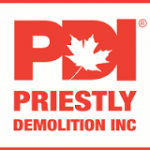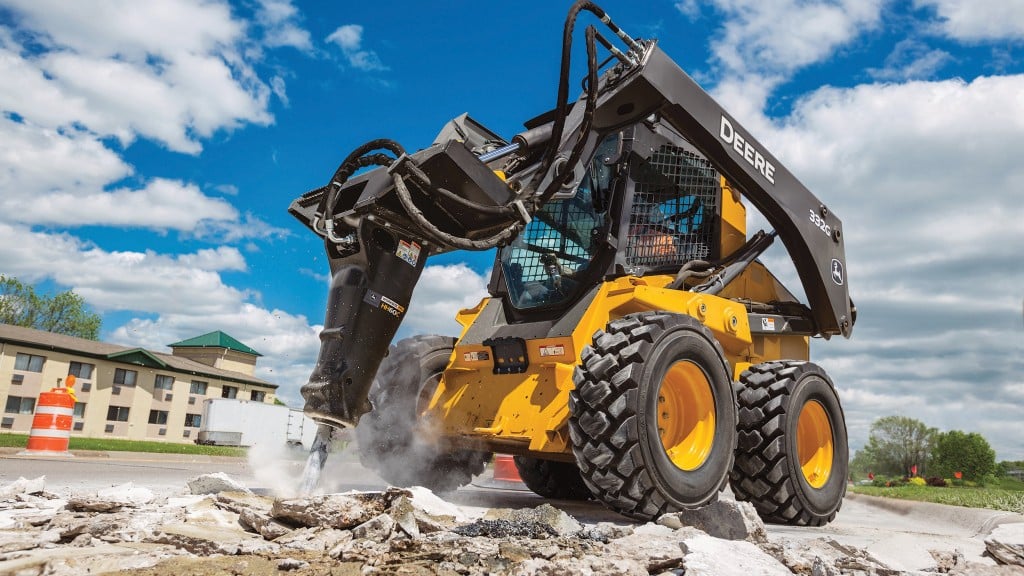
Priestly Demolition has come a long way since Vic Priestly founded his first business in 1961 at the age of 12. His first company primarily completed landscaping and snow removal work and eventually opened a garden centre in 1970. In 1971, Vic Priestly formed Vic Priestly Contracting Limited, which worked in earthworks, underground utilities, demolition, snow removal, and landscaping. The company grew dramatically, initially with the acquisition of Midway Disposal in 1974 and then National Demolition in 1988.
Vic Priestly Contracting Limited's venture into demolition began with farm structures, and the company became known as "the farm wreckers" in the early days. But Vic Priestly quickly focused on the year-round work that demolition offered. With early successes in the demolition industry, growth was on the horizon and Vic eventually unionized in 1993 with 10 employees forming what is known today as Priestly Demolition Inc (PDI).
Building on hard work, family values, and innovation in the demolition space, Priestly Demolition grew its service offerings to include demolition, excavation, remediation, hazardous material abatement, and salvage services to the commercial, industrial, and institutional sectors of construction in both Canada and the United States.
"Terminal 1 at YYZ [Toronto Pearson International Airport] in 2004 really put PDI on the map, it proved we could handle large demolition projects, establishing our trajectory for large projects in the future," says Enrique Bayata, general manger for Priestly Demolition Inc.
PDI has since expanded into Windsor, Ontario, with majority share acquisition of Jones Group in 2022; Ohio and Kentucky, USA, with a majority share acquisition of Green City Demolition in 2023; and Western Canada with the acquisition of Dakota Reclamators, a demolition, remediation, and salvage company headquartered in Calgary, Alberta, in 2021. Priestly had always done projects nationwide, but was seeking a full-time presence in the Western Canada market in order to better serve its clients. The Dakota Reclamators acquisition ultimately gave PDI that footprint in Alberta. PDI now has well over 400 employees operating in the Greater Toronto Area, Ottawa, Calgary, on the East Coast, and in the U.S.
City of Calgary uses demolition as part of its city planning strategy
As cities mature and economies change, developers look at ways to meet those changes with appropriate building and infrastructure planning. This is where demolition becomes part of the conversation. Part of a broader strategy of eliminating six million square feet of office space, the City of Calgary is revamping the downtown core by eliminating up to 200,000 square feet of vacant office spaces by 2031, dubbed the Downtown Office Demolition Incentive Program. The $3 million dollar program taps into unused funding in the city's existing downtown plan, providing grants to approved property owners for the removal of inefficient and end-of-life buildings that negatively impact the downtown vibrancy. The program subsidizes the cost of demolition, granting $15 per square foot of space demolished, with another $5 per square foot available if asbestos or other hazardous materials are identified and need to be removed. In efforts to reel in the vacancy rate and revitalize the city, the program has generated a new appetite for redeveloping office space in downtown Calgary by either retrofitting buildings or by demolition. A lot of these older office buildings were built during prior energy booms. While they have served their purpose, today they aren't needed or desired as the economy, demographics, and lifestyle of Calgarians shifts. When city planners and developers think about how they can change the downtown Calgary landscape, demolition is an important component.
PDI adds a massive KOBELCO machine to the largest demolition fleet in Canada
Priestly Demolition operates one of the largest demolition fleets in Canada, with 13 high-reach excavators in its 250+ piece fleet, making it one of Canada's most capable demolition contractors. PDI recently acquired a KOBELCO SK1600D high-reach excavator – arguably now the star of its fleet.
Beginning its life in Japan, the machine was then purchased by a group in California, after which PDI purchased the machine bringing it to Canada for a 12-storey building demolition in Edmonton and now a 10-storey building in Calgary. With 167 feet of vertical reach measured to the top pin on the fourth stick, the KOBELCO SK1600D is PDI's highest-reaching machine; when fitted with a 6,000-pound Okada processor the machine boasts a reach of 173 feet. What makes this particular machine uniquely capable of challenging demolition projects is its flexibility in configuration.
Comprised of four sections – main boom, mid stick, stick, and fourth stick commonly referred to as the "stinger" – this machine can easily be adapted to different configurations. Each section is removed by pulling pins and hydraulic quick connects. For instance, with removal of the fourth stick, the machine can be fitted with a 15,000-pound Atlas Copco CC6000 processor reaching 140 feet for demolishing elevator cores and other structurally tough components of a building.
"We brought [the KOBELCO SK1600D] out for this project in Calgary because of its reach. Not only can you reach down on the building to safely demolish floors and structural beams, but you sit farther back which gives the operator a better line of sight into the building," says Matt Baker, heavy equipment operator with Priestly Demolition Inc.
For increased visibility to the work tool when reaching up 173 feet, the cab tilts 30 degrees. A camera mounted on the fourth stick is viewable on a screen mounted in the cab. For a machine of this size and weighing 398,000 pounds, transportation is relatively quick with complete setup taking roughly one day. The machine breaks down into eight loads for transport, with assembly made easy thanks to four built-in hydraulic jacks that can raise and lower the carbody for the track frames to be attached. Using a mobile crane, 50 tonnes of counterweight fits snuggly in the back, and the 167-foot boom weighing another 50 tonnes is assembled on the ground in sections.
The SK1600D is now the largest high-reach machine in Canada, and PDI is well-positioned to meet the challenge of large demolition projects in the coming decade.
PDI's investment in an impressive fleet is paralleled by a commitment to investing in its people. Being a high-reach operator requires great skill, patience, knowing your machine, and the ability to read the building as it is demolished. "They [Priestly Demolition] observe you, they know what you are capable of, and they want to give you opportunity," says Rob Morrison, a heavy equipment operator with Priestly Demolition.
PDI thrives on challenging demolition projects
This particular project, a 140-foot-tall 10-storey building with adjacent two-storey ground level addition, was the first large project for Priestly Demolition in Calgary. Located on the corner of 17th Avenue and 4th Street, this once bustling office building did not qualify for the office demolition incentive program grant, but is certainly part of the overall picture of revamping the downtown core.
"This is our first big project in downtown Calgary. It's helping PDI establish ourselves and we are really excited to perform this with our big high-reach machine," says Bayata.
Planning for this 10-storey demolition started in 2022, with PDI mobilizing in March 2023 to begin two months of abatement work removing hazardous asbestos materials from the interior. Once complete, the remaining interior was gutted and all materials dropped down the elevator shaft where a skid steer loaded out material into bins and onto highway trucks. This particular project certainly didn't come without its challenges, but Priestly thrives on the challenge that demolition presents.
"One of the challenges we had with this project was the fact there were no engineering records or blueprints on file for the building. Our in-house engineering team used scanners, computer-based modelling software, and performed test cuts into the building's structure to determine rebar presence and type, concrete thickness, and overall structural condition of the building as it has aged," explains Cesar Ortiz, lead engineer with Priestly Demolition Inc.
PDI has an in-house engineering team, and by using Building Information Modelling software (BIM) to scan and model buildings, PDI was able to produce an engineering model of the building, make pertinent calculations, and provide 3D structural drawings for demolition planning. In the scenario of this 10-storey building with a 2-storey addition, these in-house resources proved to be incredibly advantageous.
Once the building was stripped of all materials down to a concrete and rebar skeleton, the high-reach excavators and other equipment moved in to start demolition. Demolition on this project began with removal of the 2-storey adjacent building and associated underground parking. Once complete, there was room to stage the KOBELCO machine for the main demolition. PDI used a crane to remove pre-cast concrete panels that formed the building's facade, and then the KOBELCO SK1600D had its chance to shine.
Starting on floor eight and working up to the roof, the machine removed floors then collapsed structural columns and beams inward. Surrounded on three sides by active roadways with vehicular and pedestrian traffic, in addition to a restaurant 10 feet away on another side, PDI's people and safe demolition practices were really put to the test. PDI used two cranes to hold up large screens to prevent any demolition material from leaving the site footprint. One 100-tonne crane held up a 127-foot screen and a 65-tonne crane held up an 80-foot screen adjacent to the demolition excavator as it worked the upper floors. After the KOBELCO machine removed upper floors, support equipment including a CASE CX460 with 98-foot Jewel high-reach boom and Komatsu PC490 with Atlas Copco processor handled the lower floors. Nearly everything in the building was recycled – from concrete and rebar to wood and other metals.
Successful projects like this, and the investment in people, safety, and machines, to complete them, are a fine example of Priestly Demolition's capabilities as the company continues to grow into Western Canada and other regions of North America.
Mack Plovie is the president and chief dirt enthusiast of Earthmovers Media Group.



